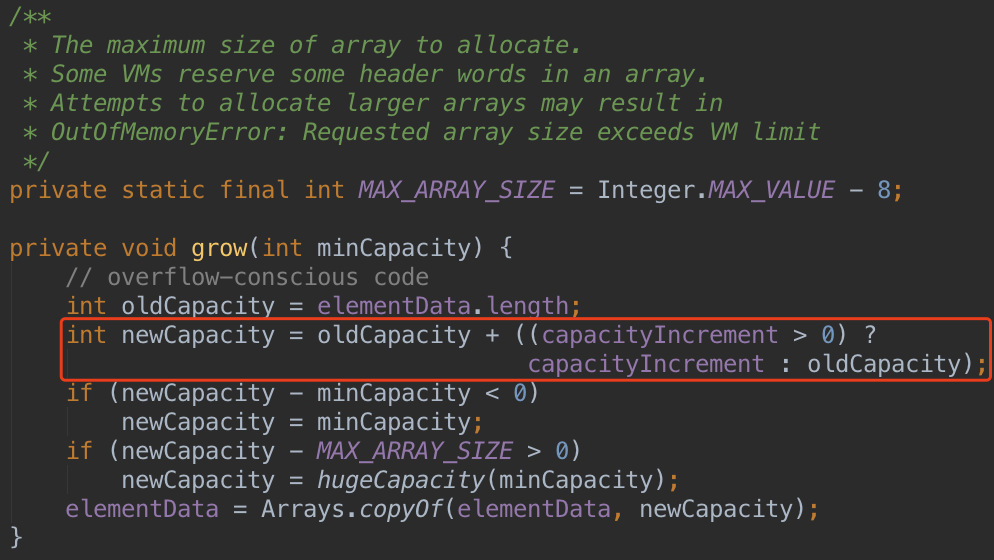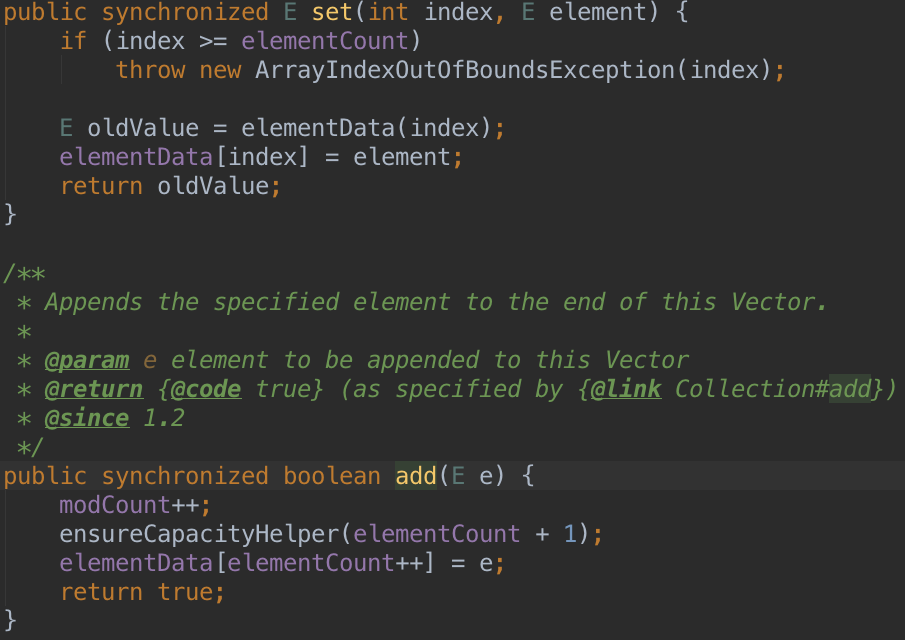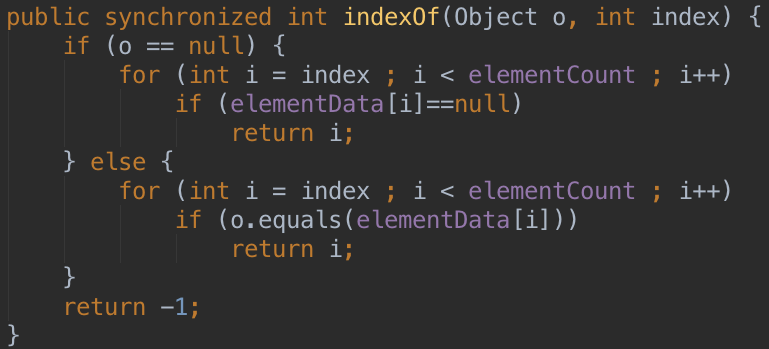【Java集合系列三】Vector-Stack解析
2017-07-29 12:59:14
一、简介
1、Vector继承关系

2、Vector类扩容
Vector类的实现和ArrayList极其相似,都使用数组存储元素,但是扩容策略不一样,ArrayList基本是按照1.5倍的思路扩容,Vector是按照创建Vector对象时设置的capacityIncrement值递增的,如果该值没有设置或者为0,则直接Double,如下:


3、Vector的线程安全性
Vector号称是线程安全的,它的安全性来自于几乎给每个方法都添加了synchronized关键字,由于锁对象是当前对象,只要有一个线程在执行某一个加锁的方法,也就是获得到当前对象这个锁对象,其他线程基本都不能再使用这个Vector对象了...这是一种很残暴的设计,估计这可能是synchronized刚出来之时,JDK团队的一时兴奋之作吧~
举几个例子:


即便是有一些方法没有直接加synchronized关键字,至少它所调用的方法都是加了的。
4、Stack
Stack继承自Vector,提供了pop、push、peek、search等栈的特殊操作,源码如下:
package java.util; /**
* The <code>Stack</code> class represents a last-in-first-out
* (LIFO) stack of objects. It extends class <tt>Vector</tt> with five
* operations that allow a vector to be treated as a stack. The usual
* <tt>push</tt> and <tt>pop</tt> operations are provided, as well as a
* method to <tt>peek</tt> at the top item on the stack, a method to test
* for whether the stack is <tt>empty</tt>, and a method to <tt>search</tt>
* the stack for an item and discover how far it is from the top.
* <p>
* When a stack is first created, it contains no items.
*
* <p>A more complete and consistent set of LIFO stack operations is
* provided by the {@link Deque} interface and its implementations, which
* should be used in preference to this class. For example:
* <pre> {@code
* Deque<Integer> stack = new ArrayDeque<Integer>();}</pre>
*
* @author Jonathan Payne
* @since JDK1.0
*/
public
class Stack<E> extends Vector<E> {
/**
* Creates an empty Stack.
*/
public Stack() {
} /**
* Pushes an item onto the top of this stack. This has exactly
* the same effect as:
* <blockquote><pre>
* addElement(item)</pre></blockquote>
*
* @param item the item to be pushed onto this stack.
* @return the <code>item</code> argument.
* @see java.util.Vector#addElement
*/
public E push(E item) {
addElement(item); return item;
} /**
* Removes the object at the top of this stack and returns that
* object as the value of this function.
*
* @return The object at the top of this stack (the last item
* of the <tt>Vector</tt> object).
* @throws EmptyStackException if this stack is empty.
*/
public synchronized E pop() {
E obj;
int len = size(); obj = peek();
removeElementAt(len - 1); return obj;
} /**
* Looks at the object at the top of this stack without removing it
* from the stack.
*
* @return the object at the top of this stack (the last item
* of the <tt>Vector</tt> object).
* @throws EmptyStackException if this stack is empty.
*/
public synchronized E peek() {
int len = size(); if (len == 0)
throw new EmptyStackException();
return elementAt(len - 1);
} /**
* Tests if this stack is empty.
*
* @return <code>true</code> if and only if this stack contains
* no items; <code>false</code> otherwise.
*/
public boolean empty() {
return size() == 0;
} /**
* Returns the 1-based position where an object is on this stack.
* If the object <tt>o</tt> occurs as an item in this stack, this
* method returns the distance from the top of the stack of the
* occurrence nearest the top of the stack; the topmost item on the
* stack is considered to be at distance <tt>1</tt>. The <tt>equals</tt>
* method is used to compare <tt>o</tt> to the
* items in this stack.
*
* @param o the desired object.
* @return the 1-based position from the top of the stack where
* the object is located; the return value <code>-1</code>
* indicates that the object is not on the stack.
*/
public synchronized int search(Object o) {
int i = lastIndexOf(o); if (i >= 0) {
return size() - i;
}
return -1;
} /** use serialVersionUID from JDK 1.0.2 for interoperability */
private static final long serialVersionUID = 1224463164541339165L;
}
5、结尾
Vector和ArrayList的异同:
1、扩容策略不同;
2、线程安全的;
3、提供了一些独特的如removeElement()之类的方法;
4、其他方法的实现与ArrayList几乎是一致的,毕竟都是对数组的操作;
5、忽略这个类即可;
【Java集合系列三】Vector-Stack解析的更多相关文章
- Java 集合系列 05 Vector详细介绍(源码解析)和使用示例
java 集合系列目录: Java 集合系列 01 总体框架 Java 集合系列 02 Collection架构 Java 集合系列 03 ArrayList详细介绍(源码解析)和使用示例 Java ...
- Java 集合系列07之 Stack详细介绍(源码解析)和使用示例
概要 学完Vector了之后,接下来我们开始学习Stack.Stack很简单,它继承于Vector.学习方式还是和之前一样,先对Stack有个整体认识,然后再学习它的源码:最后再通过实例来学会使用它. ...
- 【转】 Java 集合系列07之 Stack详细介绍(源码解析)和使用示例
概要 学完Vector了之后,接下来我们开始学习Stack.Stack很简单,它继承于Vector.学习方式还是和之前一样,先对Stack有个整体认识,然后再学习它的源码:最后再通过实例来学会使用它. ...
- Java集合系列(三):HashSet、LinkedHashSet、TreeSet的使用方法及区别
本篇博客主要讲解Set接口的三个实现类HashSet.LinkedHashSet.TreeSet的使用方法以及三者之间的区别. 注意:本文中代码使用的JDK版本为1.8.0_191 1. HashSe ...
- Java 集合系列之 Vector详细介绍(源码解析)和使用示例
Vector简介 Vector 是矢量队列,它是JDK1.0版本添加的类.继承于AbstractList,实现了List, RandomAccess, Cloneable这些接口. Vector 继承 ...
- 【Java集合系列五】HashMap解析
2017-07-31 19:36:00 一.简介 1.HashMap作用及使用场景 HashMap利用数组+单向链表的方式,实现了key-value型数据的存储功能.HashMap的size永远是2^ ...
- 【Java集合系列二】LinkedList解析
一.简介 1.LinkedList继承关系 2.LinkedList底层实现 LinkedList使用双向链表存储数据,所以没有默认的容量,也不会有扩容一说.只有两个指针,永远指向链表的两端:firs ...
- 【Java集合系列六】LinkedHashMap解析
2017-08-14 16:30:10 1.简介 LinkedHashMap继承自HashMap,能保证迭代顺序,支持其他Map可选的操作.采用双向链表存储元素,默认的迭代序是插入序.重复插入一个已经 ...
- 【Java集合系列一】ArrayList解析
一.基础简介 1.ArrayList继承关系 2.底层用数组来存储数据,数据会在ArrayList创建的时候一并初始化.如果创建ArrayList的时候,没有设置容量,则会delay到第一次add数据 ...
随机推荐
- 【Spark-core学习之六】 Spark资源调度和任务调度
环境 虚拟机:VMware 10 Linux版本:CentOS-6.5-x86_64 客户端:Xshell4 FTP:Xftp4 jdk1.8 scala-2.10.4(依赖jdk1.8) spark ...
- videojs+hls+rtmp流媒体播放
前言:刚接触前端,小白一个,如有出错,请指正,谢谢! 注:视频格式可以分为适合本地播放的本地影像视频和适合在网络中播放的网络流媒体影像视频两大类. 一.互联网网络流媒体简介 HTTP stream是各 ...
- P1605 迷宫
P1605 迷宫 这是一道毒瘤题... 这是一道广搜题 bfs ... 代码: #include<cstdio> #include<iostream> #include< ...
- SSM项目思路整合NEW
#首先进行项目思路整体分析,具体包括哪些模块,如何实现等: 一)搭建环境 1.导包: (Spring核心包4个 + 面向切面的包4个 + SpringJDBC和事务的包各一个, SpringMVC两个 ...
- 程序员的快速开发框架:Github上 10 大优秀的开源后台控制面板
程序员的快速开发框架:Github上 10 大优秀的开源后台控制面板 Web 开发中几乎的平台都需要一个后台管理,但是从零开发一套后台控制面板并不容易,幸运的是有很多开源免费的后台控制面板可以给开发者 ...
- POI使用记录
POI CellType类型 CellType 类型 值 CELL_TYPE_NUMERIC 数值型 0 CELL_TYPE_STRING 字符串型 1 CELL_TYPE_FORMULA ...
- TASE2017
PATTERN系列之五 I. Introduction To ease the expression of real-time requirements, Dwyer, and then Konrad ...
- (转载)Unity 关于动态监听时,点击Button,返回其在数组中的下标
其实是绕了一圈,把数组里的元素放进数组列表里再读取它的下标 using System.Collections; using System.Collections.Generic; using Unit ...
- Java 基础 类加载器和双亲委派机制 学习笔记
转自博客:https://blog.csdn.net/weixin_38118016/article/details/79579657 文章不是我写的,但是感觉写的挺通俗易懂的,然后防止以后丢失,就转 ...
- js中字符串转数组,数组转字符串及逆序的方法
var str = "a,b,c,d,e,f,g";//声明一个字符串 str = str.split(',').reverse();//用split函数拆分成数组对象,再用rev ...
